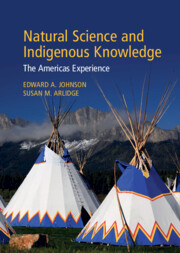Book contents
- Natural Science and Indigenous Knowledge
- Natural Science and Indigenous Knowledge
- Copyright page
- Contents
- Contributors
- Preface
- 1 What Do Indigenous People Have to Tell Us about the Cultural Landscapes They Have Created?
- 2 Reintegrating Cultural and Natural Landscapes
- 3 “My Uncle Was Resting His Country”: Dene Kinship and Insights into the More Distant Past
- 4 Native American Science in a Living Universe: A Paiute Perspective
- 5 “To Get More Harvest”
- 6 Hunting and Trapping in the Americas: The Assessment and Projection of Harvest on Wildlife Populations
- 7 On Fire and Water: The Intersection of Wetlands and Burning Strategies in Managing the Anthropogenic Plant Communities of Yosemite National Park
- 8 Indigenous Knowledge and the Kindergarten to Twelfth-Grade Science Classroom
- Index
- References
2 - Reintegrating Cultural and Natural Landscapes
Indigenous Homelands of the Alsek-Dry Bay Region, Alaska
Published online by Cambridge University Press: 11 April 2024
- Natural Science and Indigenous Knowledge
- Natural Science and Indigenous Knowledge
- Copyright page
- Contents
- Contributors
- Preface
- 1 What Do Indigenous People Have to Tell Us about the Cultural Landscapes They Have Created?
- 2 Reintegrating Cultural and Natural Landscapes
- 3 “My Uncle Was Resting His Country”: Dene Kinship and Insights into the More Distant Past
- 4 Native American Science in a Living Universe: A Paiute Perspective
- 5 “To Get More Harvest”
- 6 Hunting and Trapping in the Americas: The Assessment and Projection of Harvest on Wildlife Populations
- 7 On Fire and Water: The Intersection of Wetlands and Burning Strategies in Managing the Anthropogenic Plant Communities of Yosemite National Park
- 8 Indigenous Knowledge and the Kindergarten to Twelfth-Grade Science Classroom
- Index
- References
Summary
Landscapes are important frames for understanding and bridging environmental perspectives, including between Indigenous and scientific knowledge systems. Landscapes are both “natural” and “cultural,” for, as Indigenous societies attest, all landscapes manifest the coevolutionary interplay of human and nonhuman forces. We apply three integrated ecological lenses to analyze this interplay: historical ecology, ethno-ecology, and political ecology. Our case study is the Alsek-Dry Bay region of Southeast Alaska and Western Canada, at the intersection of the northern Tlingit and Athabaskan worlds. Historically an epicenter of astonishing geological dynamism and disruption, biological productivity and diversity, this landscape was also a mecca of cultural exchange, contestation, and appropriation. Ironically, the Alsek-Dry Bay landscape is now “preserved” as the center of a celebrated World Heritage Site based solely on its “natural” landscapes and “wilderness” character, and not for its Indigenous identity as a place of outstanding cultural significance – where the trickster-worldmaker Raven literally transformed the cosmos and topography – and the product of deep cultural-environmental histories. Bringing these ecological perspectives together enables a broader appreciation of the natural and cultural dynamism that has shaped such sites and of the enduring value and lessons of Indigenous knowledge systems that have coevolved with rapidly changing landscapes.
- Type
- Chapter
- Information
- Natural Science and Indigenous KnowledgeThe Americas Experience, pp. 7 - 31Publisher: Cambridge University PressPrint publication year: 2024



